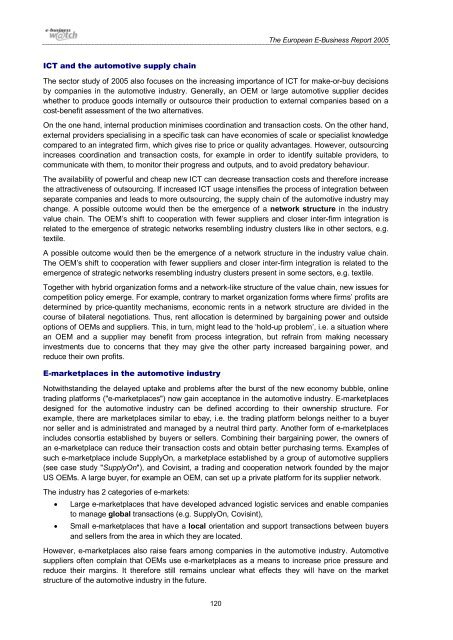The European e-Business Report The European e ... - empirica
The European e-Business Report The European e ... - empirica
The European e-Business Report The European e ... - empirica
You also want an ePaper? Increase the reach of your titles
YUMPU automatically turns print PDFs into web optimized ePapers that Google loves.
<strong>The</strong> <strong>European</strong> E-<strong>Business</strong> <strong>Report</strong> 2005<br />
ICT and the automotive supply chain<br />
<strong>The</strong> sector study of 2005 also focuses on the increasing importance of ICT for make-or-buy decisions<br />
by companies in the automotive industry. Generally, an OEM or large automotive supplier decides<br />
whether to produce goods internally or outsource their production to external companies based on a<br />
cost-benefit assessment of the two alternatives.<br />
On the one hand, internal production minimises coordination and transaction costs. On the other hand,<br />
external providers specialising in a specific task can have economies of scale or specialist knowledge<br />
compared to an integrated firm, which gives rise to price or quality advantages. However, outsourcing<br />
increases coordination and transaction costs, for example in order to identify suitable providers, to<br />
communicate with them, to monitor their progress and outputs, and to avoid predatory behaviour.<br />
<strong>The</strong> availability of powerful and cheap new ICT can decrease transaction costs and therefore increase<br />
the attractiveness of outsourcing. If increased ICT usage intensifies the process of integration between<br />
separate companies and leads to more outsourcing, the supply chain of the automotive industry may<br />
change. A possible outcome would then be the emergence of a network structure in the industry<br />
value chain. <strong>The</strong> OEM’s shift to cooperation with fewer suppliers and closer inter-firm integration is<br />
related to the emergence of strategic networks resembling industry clusters like in other sectors, e.g.<br />
textile.<br />
A possible outcome would then be the emergence of a network structure in the industry value chain.<br />
<strong>The</strong> OEM’s shift to cooperation with fewer suppliers and closer inter-firm integration is related to the<br />
emergence of strategic networks resembling industry clusters present in some sectors, e.g. textile.<br />
Together with hybrid organization forms and a network-like structure of the value chain, new issues for<br />
competition policy emerge. For example, contrary to market organization forms where firms’ profits are<br />
determined by price-quantity mechanisms, economic rents in a network structure are divided in the<br />
course of bilateral negotiations. Thus, rent allocation is determined by bargaining power and outside<br />
options of OEMs and suppliers. This, in turn, might lead to the ‘hold-up problem’, i.e. a situation where<br />
an OEM and a supplier may benefit from process integration, but refrain from making necessary<br />
investments due to concerns that they may give the other party increased bargaining power, and<br />
reduce their own profits.<br />
E-marketplaces in the automotive industry<br />
Notwithstanding the delayed uptake and problems after the burst of the new economy bubble, online<br />
trading platforms ("e-marketplaces") now gain acceptance in the automotive industry. E-marketplaces<br />
designed for the automotive industry can be defined according to their ownership structure. For<br />
example, there are marketplaces similar to ebay, i.e. the trading platform belongs neither to a buyer<br />
nor seller and is administrated and managed by a neutral third party. Another form of e-marketplaces<br />
includes consortia established by buyers or sellers. Combining their bargaining power, the owners of<br />
an e-marketplace can reduce their transaction costs and obtain better purchasing terms. Examples of<br />
such e-marketplace include SupplyOn, a marketplace established by a group of automotive suppliers<br />
(see case study "SupplyOn"), and Covisint, a trading and cooperation network founded by the major<br />
US OEMs. A large buyer, for example an OEM, can set up a private platform for its supplier network.<br />
<strong>The</strong> industry has 2 categories of e-markets:<br />
• Large e-marketplaces that have developed advanced logistic services and enable companies<br />
to manage global transactions (e.g. SupplyOn, Covisint),<br />
• Small e-marketplaces that have a local orientation and support transactions between buyers<br />
and sellers from the area in which they are located.<br />
However, e-marketplaces also raise fears among companies in the automotive industry. Automotive<br />
suppliers often complain that OEMs use e-marketplaces as a means to increase price pressure and<br />
reduce their margins. It therefore still remains unclear what effects they will have on the market<br />
structure of the automotive industry in the future.<br />
120

















